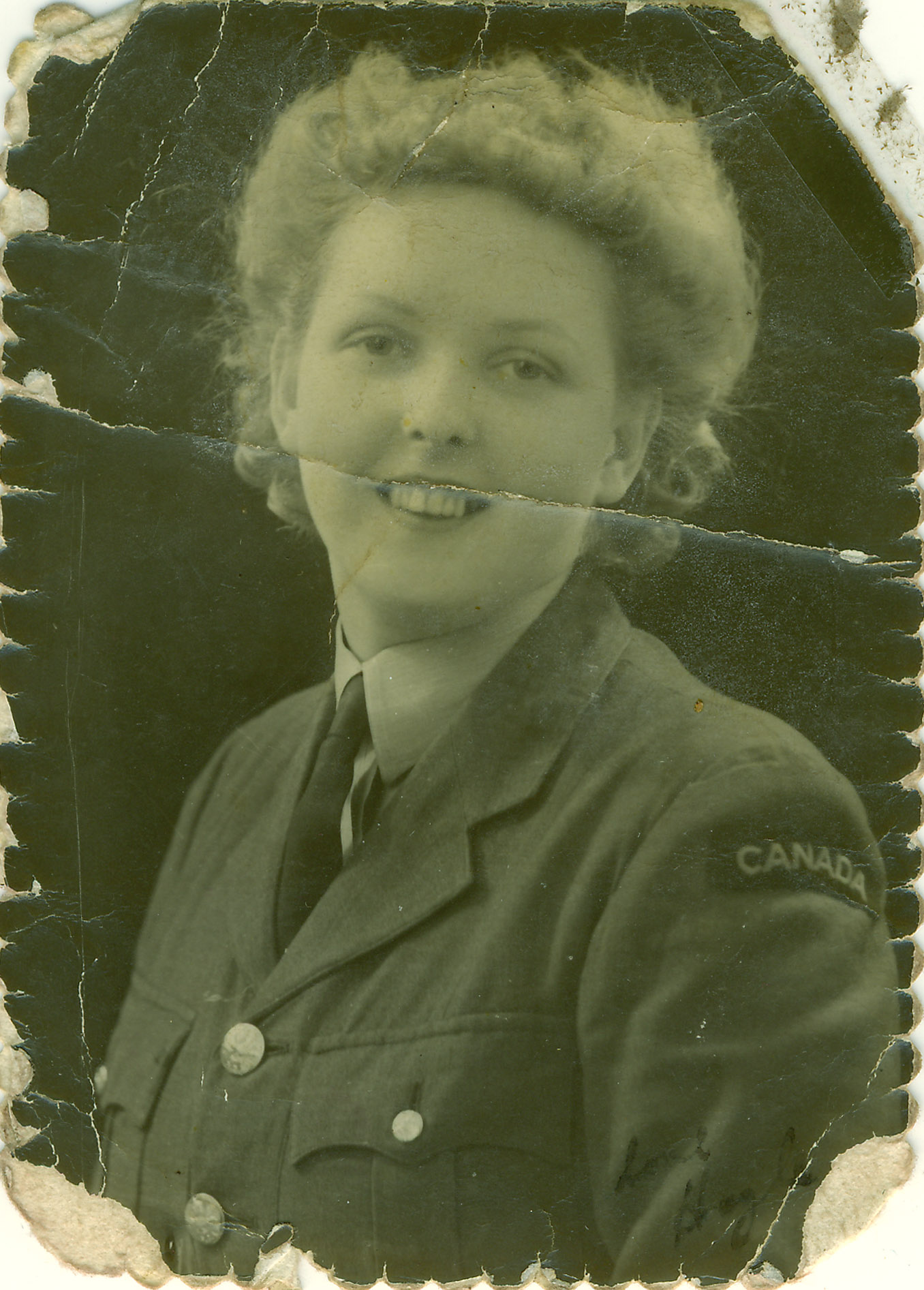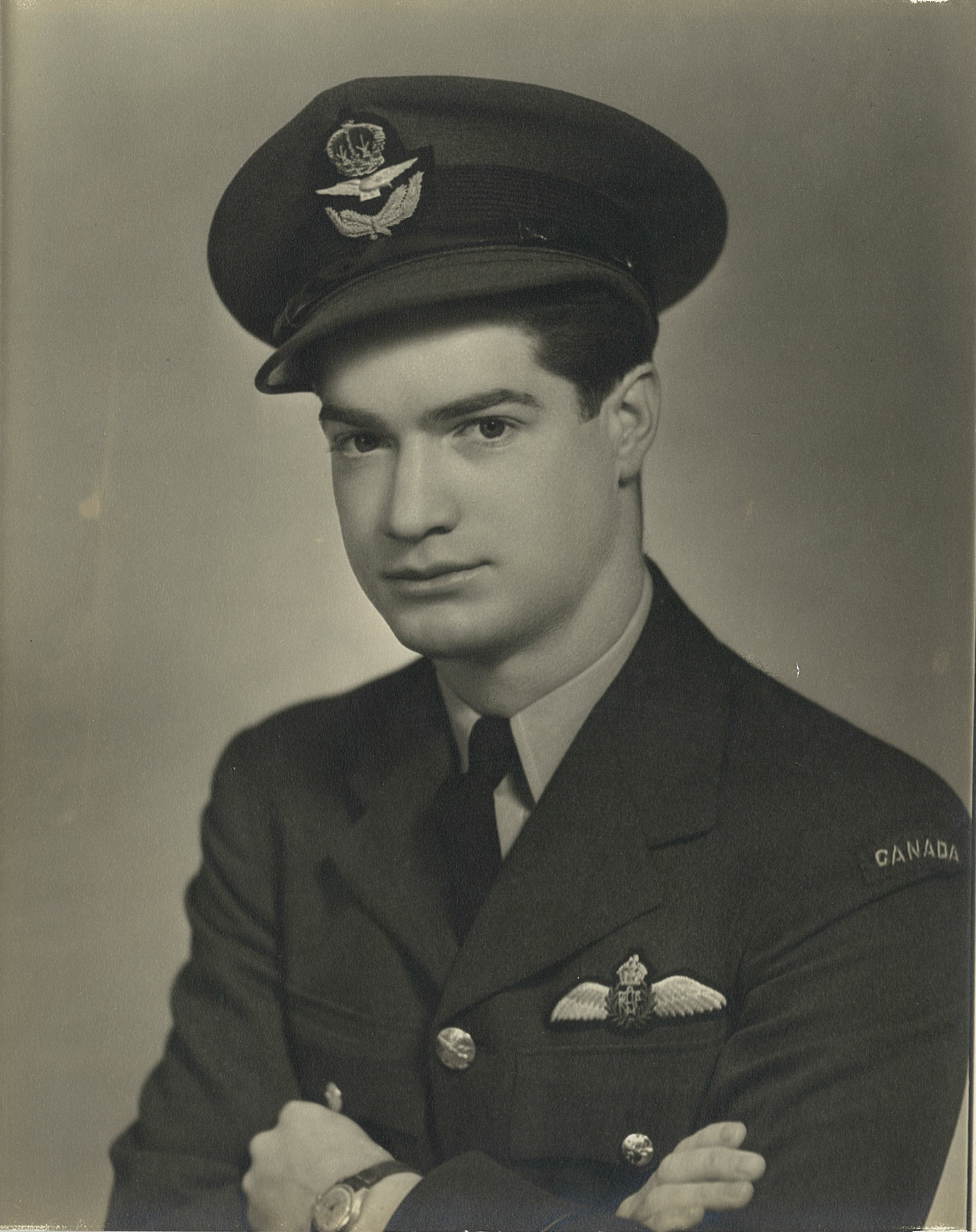Browse "Air Force"
-
Memory Project Archive
Gordon Webb (Primary Source)
Gordon Webb served with the Royal Canadian Air Force as a bomber pilot in the Second World War. He flew in 72 missions over the enemy territory, including the raid against the German city of Nuremberg, 30-31 March 1944. Webb also served with No. 405 Squadron, RCAF on Pathfinder Lancaster bombers.Please be advised that Memory Project primary sources may deal with personal testimony that reflect the speaker’s recollections and interpretations of events. Individual testimony does not necessarily reflect the views of the Memory Project and Historica Canada.
"https://d2ttikhf7xbzbs.cloudfront.net/The-Memory-Project/image/13383_original.jpg" // resources/views/front/categories/view.blade.php
https://d2ttikhf7xbzbs.cloudfront.net/The-Memory-Project/image/13383_original.jpg
-
Memory Project Archive
Gordon Wilson (Primary Source)
Gordon Wilson was born on 5 December 1917 in Limerick, Saskatchewan, and enlisted in the Royal Canadian Air Force in 1940. He was sent overseas in 1941, where his squadron was moved to the Royal Air Force (RAF). Wilson served as a fighter pilot with the RAF, flying Spitfires with No. 134, No. 213, and No. 92 Squadrons, in the North Africa and Mediterranean theatres. In this testimony, he recalls fighter sweeps over El Alamein, Egypt, and Cape Bon, Tunisia, actions that helped the Allies declare victory in the North Africa campaign on 13 May 1943. He also recounts an emergency landing in Sicily in 1944. Wilson returned to Canada after the war and graduated from the University of Saskatchewan with a Bachelor of Science in Agriculture. He served as Executive Director of the Western Development Museum of Saskatchewan and was a founder of the Saskatchewan Agricultural Hall of Fame. Gordon Wilson died on 31 May 2015 in Saskatoon. Please be advised that Memory Project primary sources may deal with personal testimony that reflect the speaker’s recollections and interpretations of events. Individual testimony does not necessarily reflect the views of the Memory Project and Historica Canada.
"https://d2ttikhf7xbzbs.cloudfront.net/The-Memory-Project/image/1282_original.jpg" // resources/views/front/categories/view.blade.php
https://d2ttikhf7xbzbs.cloudfront.net/The-Memory-Project/image/1282_original.jpg
-
Memory Project Archive
Harold Bronson (Primary Source)
"I ended up flying a Tiger Moth, which is a small training plane. And I flew it and I landed it right by my house, in northwest of Edmonton, got out and showed my folks" See below for Mr. Bronson's entire testimony. Please be advised that Memory Project primary sources may deal with personal testimony that reflect the speaker’s recollections and interpretations of events. Individual testimony does not necessarily reflect the views of the Memory Project and Historica Canada.
"https://d2ttikhf7xbzbs.cloudfront.net/MemoryProject/HaroldBronson/227_original.jpg" // resources/views/front/categories/view.blade.php
https://d2ttikhf7xbzbs.cloudfront.net/MemoryProject/HaroldBronson/227_original.jpg
-
Memory Project Archive
Harry "Acky" Acton
TranscriptFirst of course in Mountain View, just out of Trenton, Ontario. From there I went to [Royal Canadian Air Force Station] Fingal and we flew, the base flew, I was an armourer, on Bolingbrokes [trainer aircraft], which probably very few people have heard of. And we did training exercises for air crew over the lake, particularly operating turrets and firing machine guns. And I finished a tour there and I was transferred overseas. And part...
"https://d2ttikhf7xbzbs.cloudfront.net/The-Memory-Project/image/2594_original.jpg" // resources/views/front/categories/view.blade.php
https://d2ttikhf7xbzbs.cloudfront.net/The-Memory-Project/image/2594_original.jpg
-
Memory Project Archive
Harry Robert Bob Eager (Primary Source)
Harry Eager served in the Royal Canadian Air Force during the Second World War.Please be advised that Memory Project primary sources may deal with personal testimony that reflect the speaker’s recollections and interpretations of events. Individual testimony does not necessarily reflect the views of the Memory Project and Historica Canada.
"https://d2ttikhf7xbzbs.cloudfront.net/The-Memory-Project/image/2889_original.jpg" // resources/views/front/categories/view.blade.php
https://d2ttikhf7xbzbs.cloudfront.net/The-Memory-Project/image/2889_original.jpg
-
Memory Project Archive
Harry Schmuck (Primary Source)
Harry Schmuck served as an air gunner with a Royal Canadian Air Force bomber crew during the Second World War.Please be advised that Memory Project primary sources may deal with personal testimony that reflect the speaker’s recollections and interpretations of events. Individual testimony does not necessarily reflect the views of the Memory Project and Historica Canada.
"https://development.thecanadianencyclopedia.ca/images/tce_placeholder.jpg?v=e9dca980c9bdb3aa11e832e7ea94f5d9" // resources/views/front/categories/view.blade.php
https://development.thecanadianencyclopedia.ca/images/tce_placeholder.jpg?v=e9dca980c9bdb3aa11e832e7ea94f5d9
-
Memory Project Archive
Hazel Wylie (Primary Source)
The Memory Project interviewed Hazel Wylie, a veteran of the Second World War. The following recording (and transcript) is an excerpt from this interview. Born in 1924 in Quebec, Wylie served overseas in England with the Royal Air Force, where she worked as an equipment assistant. She helped train incoming girls, and kept track of supplies such as clothing, nuts and bolts, and bigger aircraft parts. In this testimony, Wylie describes her duties as equipment assistant, as well as some of her experiences at Training Command in Newton, Nottingham. She also describes her bicycle accident during a blackout, and the segregation of white and Black American soldiers at one of the camps. Wylie died on 18 December 2013 at age 89 in Carleton Place, Ontario. Please be advised that Memory Project primary sources may deal with personal testimony that reflect the speaker’s recollections and interpretations of events. Individual testimony does not necessarily reflect the views of the Memory Project and Historica Canada.
"https://d2ttikhf7xbzbs.cloudfront.net/The-Memory-Project/image/8876_original.jpg" // resources/views/front/categories/view.blade.php
https://d2ttikhf7xbzbs.cloudfront.net/The-Memory-Project/image/8876_original.jpg
-
Memory Project Archive
Hugh Bartley (Primary Source)
"Mainly you’re so busy you don’t have time to get scared. You’re trying to get out of whatever kind of a problem you got into, and in this case the airplane made it simple for us."Hugh Bartley served in the Royal Canadian Air Force during the Second World War. See his full testimony below.Please be advised that Memory Project primary sources may deal with personal testimony that reflect the speaker’s recollections and interpretations of events. Individual testimony does not necessarily reflect the views of the Memory Project and Historica Canada.
"https://d2ttikhf7xbzbs.cloudfront.net/mpsb/vimy/HughBartley/567_resize.jpg" // resources/views/front/categories/view.blade.php
https://d2ttikhf7xbzbs.cloudfront.net/mpsb/vimy/HughBartley/567_resize.jpg
-
Memory Project Archive
Irene Jennie Miller nee Girard (Primary Source)
In 2010, The Memory Project interviewed Irene Miller, a veteran of the Second World War. The following recording (and transcript) is an excerpt from this interview. Miller joined the Royal Canadian Air Force Women’s Division and completed basic training at the RCAF Station Rockcliffe in Ottawa. She was then sent to Halifax, where she eventually married her husband, a member of the Royal Canadian Navy. In this testimony, Miller describes her role in the signals branch, where she would log and transfer messages. She also discusses the appearance of U-boats (German submarines) in Halifax harbour and the high cost of accommodations in the city. Please be advised that Memory Project primary sources may deal with personal testimony that reflect the speaker’s recollections and interpretations of events. Individual testimony does not necessarily reflect the views of the Memory Project and Historica Canada.
"https://development.thecanadianencyclopedia.ca/images/tce_placeholder.jpg?v=e9dca980c9bdb3aa11e832e7ea94f5d9" // resources/views/front/categories/view.blade.php
https://development.thecanadianencyclopedia.ca/images/tce_placeholder.jpg?v=e9dca980c9bdb3aa11e832e7ea94f5d9
-
Memory Project Archive
Ivor Williams (Primary Source)
Ivor Williams joined the RCAF and served with 443 Squadron as a Spitfire pilot. Prior to D-Day he flew various operations, bombing and strafing enemy positions to hinder any German reinforcements travelling to the Normandy beaches. On D-Day he assisted in patrolling Juno Beach, warding off enemy fighters and providing cover for ships.Please be advised that Memory Project primary sources may deal with personal testimony that reflect the speaker’s recollections and interpretations of events. Individual testimony does not necessarily reflect the views of the Memory Project and Historica Canada.
"https://d2ttikhf7xbzbs.cloudfront.net/The-Memory-Project/image/13566_original.jpg" // resources/views/front/categories/view.blade.php
https://d2ttikhf7xbzbs.cloudfront.net/The-Memory-Project/image/13566_original.jpg
-
Memory Project Archive
Jack H. Davies (Primary Source)
Jack Davies was a pilot with 2nd Tactical Air Force, Royal Air Force (RAF) during the Second World War. Davies flew B-25 Mitchell medium bombers in support of British and Canadian forces advancing through Northwest Europe.
"https://d2ttikhf7xbzbs.cloudfront.net/The-Memory-Project/image/16200_original.jpg" // resources/views/front/categories/view.blade.php
https://d2ttikhf7xbzbs.cloudfront.net/The-Memory-Project/image/16200_original.jpg
-
Memory Project Archive
Jack Henry Hilton (Primary Source)
"We landed in France on a metal strip. I had a sniper bullet go across my head as I landed as I was taxing in and we slept in slit trenches and tents, ate bully beef and did our, we attacked the Germans." See below for Mr. Hilton's entire testimony. Please be advised that Memory Project primary sources may deal with personal testimony that reflect the speaker’s recollections and interpretations of events. Individual testimony does not necessarily reflect the views of the Memory Project and Historica Canada.
"https://d2ttikhf7xbzbs.cloudfront.net/MemoryProject/JackHenryHilton/7680_original.jpg" // resources/views/front/categories/view.blade.php
https://d2ttikhf7xbzbs.cloudfront.net/MemoryProject/JackHenryHilton/7680_original.jpg
-
Memory Project Archive
Jack Western (Primary Source)
"The plane itself went down in what we call a flat corkscrew. Circling round and round and round and round and round...from about 12,000 feet" See below for Mr. Western's entire testimony. Please be advised that Memory Project primary sources may deal with personal testimony that reflect the speaker’s recollections and interpretations of events. Individual testimony does not necessarily reflect the views of the Memory Project and Historica Canada.
"https://d2ttikhf7xbzbs.cloudfront.net/MemoryProject/JackWestern/8838_538.jpg" // resources/views/front/categories/view.blade.php
https://d2ttikhf7xbzbs.cloudfront.net/MemoryProject/JackWestern/8838_538.jpg
-
Memory Project Archive
James Annett (Primary Source)
James Annett served in the Royal Canadian Air Force during the Second World War. See his full testimony below.Please be advised that Memory Project primary sources may deal with personal testimony that reflect the speaker’s recollections and interpretations of events. Individual testimony does not necessarily reflect the views of the Memory Project and Historica Canada.
"https://d2ttikhf7xbzbs.cloudfront.net/mpsb/vimy/JamesAnnett/4600_resize.jpg" // resources/views/front/categories/view.blade.php
https://d2ttikhf7xbzbs.cloudfront.net/mpsb/vimy/JamesAnnett/4600_resize.jpg
-
Memory Project Archive
James Eddy (Primary Source)
"They went very well, until we got shot down on January the 15th, I think it was. Our target was Merseburg." See below for Mr. Eddy's entire testimony. Please be advised that Memory Project primary sources may deal with personal testimony that reflect the speaker’s recollections and interpretations of events. Individual testimony does not necessarily reflect the views of the Memory Project and Historica Canada.
"https://d2ttikhf7xbzbs.cloudfront.net/MemoryProject/JamesEddy/7784_original.jpg" // resources/views/front/categories/view.blade.php
https://d2ttikhf7xbzbs.cloudfront.net/MemoryProject/JamesEddy/7784_original.jpg
